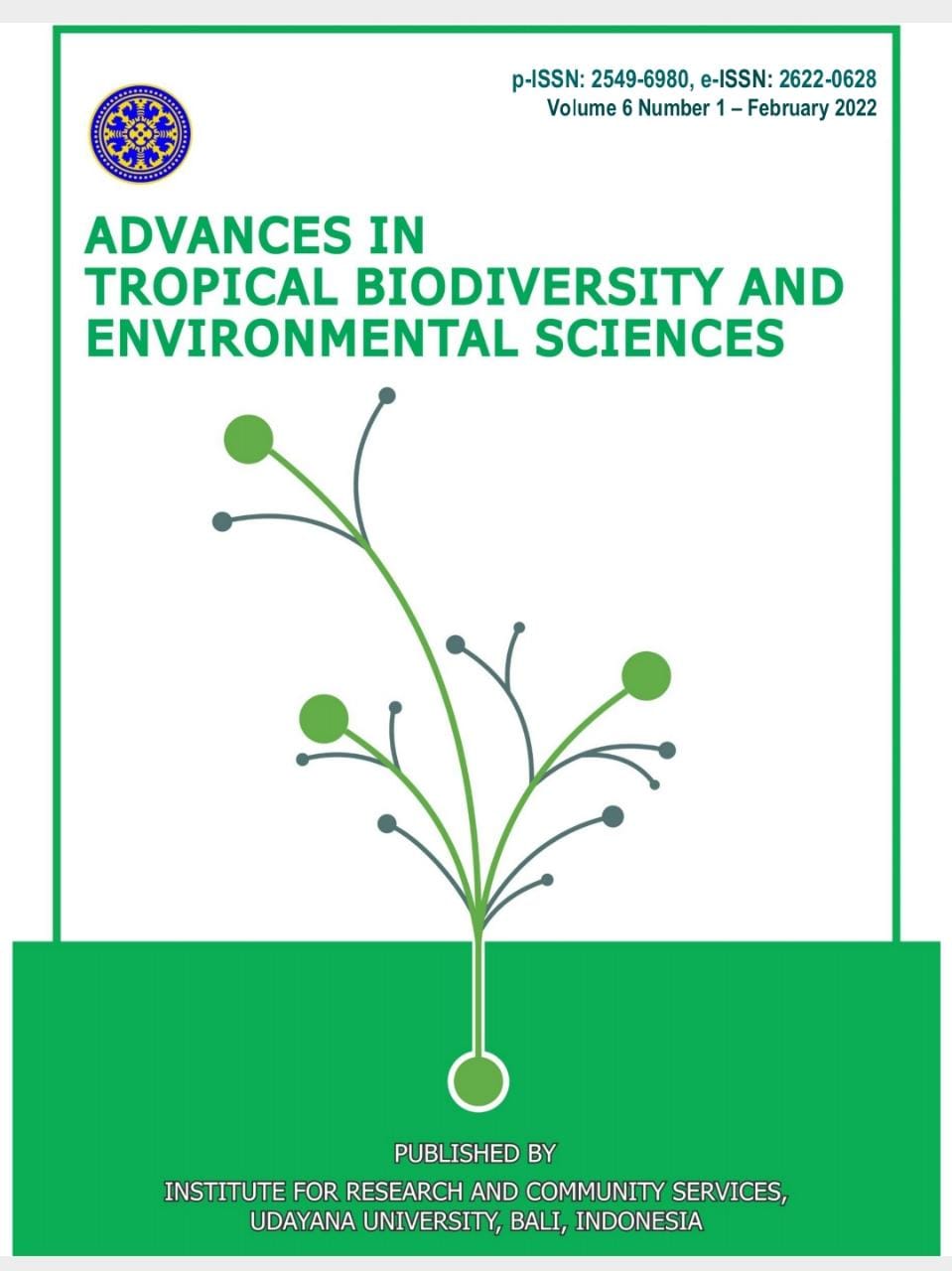Composting of Banana Leaves and Coconut Leaves Using EM4 Bioactivator
Abstract
The generation of organic waste is one of the biggest problems in developing countries like Indonesia. Examples of organic waste that can be obtained, such as leaves, include banana leaves and coconut leaves. One way to process waste that can generally be done is by composting. In the composting process, a bioactivator such as EM4 is needed to accelerate the reaction process in the waste. This study aimed to determine the effectiveness of EM4 bioactivator in the degradation process of banana leaf and coconut leaf waste. Measurement of processing quality is measured in-situ with parameters of temperature, pH, and humidity. The waste temperature increased above 32oC for the addition of EM4 bioactivator, while without the addition of bioactivator it only increased to 31oC. pH tended to be in normal conditions and was in an acidic state on day 12. Humidity decreased from the beginning of the waste process to the end of the process. The final result of composting quality has met the criteria of SNI 19-7030-2004. There was also a decrease in the C/N content during the process, adjusting to soil conditions. The decrease in the value of C/N on the addition of bioactivator also influences the composting process.
Downloads
References
[2] I. W. K. Suryawan, A. Sarwono, I. Y. Septiariva, and C.-H. Lee, “Evaluating Marine Debris Trends and the Potential of Incineration in the Context of the COVID-19 Pandemic in Southern Bali, Indonesia,” J. Ilm. Perikan. dan Kelaut., vol. 13, no. 1, 2021.
[3] C.-P. In, P. City, Y. Ruslinda, R. Aziz, and F. F. Putri, “Indonesian Journal of Environmental Management and Sustainability Analysis of Household Solid Waste Generation and Composition During The,” Indones. J. Environ. Manag. Sustain. Indones. J. Environ. Manag. Sustain., p. 9, 2020.
[4] I. D. A. A. Warmadewanthi et al., “Socio-economic impacts of the COVID-19 pandemic on waste bank closed-loop system in Surabaya, Indonesia,” Waste Manag. Res., vol. 39, no. 8, pp. 1039–1047, 2021, doi: 10.1177/0734242X211017986.
[5] I. M. W. Wijaya and I. K. A. Putra, “Potensi Daur Ulang Sampah Upacara Adat,” vol. 1, pp. 1–8, 2021, [Online]. Available: https://e-journal.unmas.ac.id/index.php/jeco/article/view/1763/1403.
[6] R. A. Saputra, N. Sari, and I. R. Pratama, “Status fisika-kimia kompos berbahan dasar daun akasia, sekam padi dan kulit udang menggunakan biodekomposer Tricoderma sp. dan bakteri selulolitik,” Pros. Semin. Nas. Lingkung. Lahan Basah, vol. Vol 5 No 3, no. April, pp. 109–115, 2020.
[7] I. W. K. Suryawan, G. Prajati, A. S. Afifah, M. Rizki, and Y. Adicita, “Continuous Piggery Wastewater Treatment With Anaerobic Baffled Reactor ( Abr ) By Bio-Activator Effective Microorganisms ( Em4 ),” vol. 3, no. 1, pp. 1–12, 2019.
[8] N. Ekawandani, “Efektifitas Kompos Daun Menggunakan Em4 Dan Kotoran Sapi,” vol. 12, no. 2, 2018, doi: 10.31227/osf.io/pyqaj.
[9] U. Munawaroh, M. Sutisna, and K. Pharmawati, “Penyisihan Parameter Pencemar Lingkungan pada Limbah Cair Industri Tahu Menggunakan Efektif Mikroorganisme 4 (EM4) Serta Pemanfaatannya,” J. Inst. Teknol. Nas., vol. 1, no. 2, pp. 93–104, 2013.
[10] F. L. Sahwan, “Kualitas Produk Kompos dan Karakteristik Proses Pengomposan Sampah Kota Tanpa Pemilahan Awal,” J. Tek. Lingkung., vol. 11, no. 1, pp. 79–85, 2010.
[11] A. R. Putri, G. Samudro, and D. S. Handayani, “Penentuan Rasio BOD/COD Optimal Pada Reaktor Aerob , Fakultatif dan Anaerob,” Penentuan Rasio BOD/COD Optim. pada Reakt. Aerob, pp. 1–5, 2012.
[12] M. I. Maulana and M. A. Muslim, “Sistem Prediksi Tagihan Listrik Usaha Jasa Laundry Menggunakan Jaringan Syaraf Tiruan Backpropagation Muhamad,” UNNES J. Math., vol. 4, no. 1, pp. 58–66, 2015.
[13] Irvan, Permata Mhardela, and Bambang Trisakti, “Pengaruh Penambahan Berbagai Aktivator Dalam Proses Pengomposan Sekam Padi (Oryza sativa),” J. Tek. Kim. USU, vol. 3, no. 2, pp. 5–9, 2014, doi: 10.32734/jtk.v3i2.1501.
[14] M. L. Zupancic et al., “Analysis of the gut microbiota in the old order amish and its relation to the metabolic syndrome,” PLoS One, vol. 7, no. 8, pp. 1–10, 2012, doi: 10.1371/journal.pone.0043052.
[15] G. Tchobanoglous and S. A. Vigil, Integrated solid waste managementengineering principles and management. New York: McGraw-Hill, 1993.
[16] G. Bellingan, “Co Re Co Re,” Europe, no. september, pp. 2–5, 2007, doi: 10.1007/978-3-319-12616-6.
[17] I. I. Krstic, J. Radosavljević, A. Djordjević, D. Avramović, and A. Vukadinović, “Composting As a Method of Biodegradable Waste Management,” Facta Univ. Ser. Work. Living Environ. Prot., vol. 15, p. 135, 2019, doi: 10.22190/fuwlep1802135i.
[18] Y. Yuriandala, N. Laily, and F. B. Maziya, “Vegetable Waste and Food Waste Treatment Using Modified Aerobic Composting Reactor,” Appl. Mech. Mater., vol. 898, pp. 16–22, 2020, doi: 10.4028/www.scientific.net/amm.898.16.
[19] Y. H. Indriani, Membuat Kompos Secara Singkat. Penebar Swadaya, 1999.
[20] M. Juliandari, A. Nirmala, and E. Yuniarti, “Efektivitas Lubang Resapan Biopori Terhadap Laju Resapan (INFILTRASI ),” J. Teknol. Lingkung. Lahan Basah, vol. 1, no. 1, pp. 1–10, 2013.
[21] S. P. Mathur, G. Owen, H. Dinel, and M. Schnitzer, “Determination of Compost Biomaturity. I. Literature Review,” Biol. Agric. Hortic., vol. 10, no. 2, pp. 65–85, Jan. 1993, doi: 10.1080/01448765.1993.9754655.
[22] S. H. Wahyuni and D. P. Y. Nasution, “Utilization of Trichoderma viride as organic fertilizer to induce the resistance of banana seeds on Fusarium oxysporum f.sp cubense (FOC),” IOP Conf. Ser. Earth Environ. Sci., vol. 260, no. 1, 2019, doi: 10.1088/1755-1315/260/1/012149.
[23] E. A. Purnomo, E. Sutrisno, and S. Sumiyati, “Pengaruh variasi C/N rasio terhadap produksi kompos dan kandungan kalium (K), pospat (P) dari batang pisang dengan kombinasi kotoran sapi dalam sistem vermicomposting,” J. Tek. Lingkung., vol. 6, no. 2, 2017.













